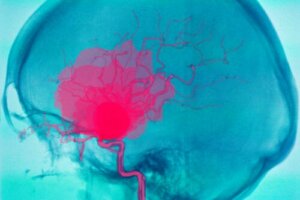What's an Intracerebral Hemorrhage and Why Might it Occur?


Written and verified by the doctor Leonardo Biolatto
An intracerebral hemorrhage is a serious situation that can put a person’s life at risk. It consists of bleeding inside the brain. Because of this, other body parts are deprived of oxygen.
Therefore, it’s the second leading cause of stroke. The problem is that the mortality of intracerebral hemorrhage, despite current treatments, is still very high. In addition, deficits are common in those who manage to survive.
The incidence of this condition increases as you age. However, age isn’t the only risk factor.
Let’s take a closer look.
What’s an intracerebral hemorrhage?
An intracerebral hemorrhage, as we mentioned in the introduction, is bleeding that occurs inside the brain. It usually causes sudden-onset neurological defects and even coma.
This is due to the lack of blood supply to other parts of the brain, since the blood doesn’t continue its journey through the blood vessels. It’s important to distinguish between intracerebral and intracranial hemorrhage.
Intracranial hemorrhages, in addition to intracerebral hemorrhages, include others that occur inside the skull but not in the brain parenchyma. For example, intraventricular, subarachnoid, subdural, and epidural hemorrhages.
Intracerebral hemorrhage is one of the main causes of stroke. In fact, experts estimate that almost 15% of all strokes are caused by this condition. In addition, it has a high mortality rate, especially in the first days.
You may like this article: Insomnia Increases the Risk of Heart Attack and Stroke
Related symptoms
As we just explained, intracerebral hemorrhage is usually associated with a neurological defect that appears abruptly. Depending on the cause of the bleeding, it may progress very quickly (within one to two hours) or more slowly. In addition, the symptoms vary depending on the affected area.
As in ischemic strokes, loss of strength in one half of the body is common. In other words, if the bleeding occurred in the right side of the brain, the left legs and arms will be affected.
It’s common for the same side to lose sensitivity or for tingling to appear. It can also affect speech or the ability to understand language. Some people lose vision in one eye.
Headache, vomiting, loss of consciousness, and even coma are common symptoms. Headache and vomiting are usually associated with an increased intracranial pressure due to the intracerebral hemorrhage itself.

This article may interest you: Nine Foods that May Help Reduce Your Risk of Thrombosis and Stroke
The main causes of intracerebral hemorrhage
This condition can occur due to different reasons. Age is one of the most relevant factors. The incidence increases as you age and is higher in men than in women.
The main underlying cause is high blood pressure or hypertension. This is because the cerebral arteries, which are small in size, are very sensitive to increased pressure.
Similarly, trauma can trigger an intracerebral hemorrhage. This is one of the reasons why it’s more common in the elderly, who tend to suffer falls.
Another cause is cerebral amyloid angiopathy (CAA). It’s a disease that consists of the buildup of certain proteins in the walls of the arteries of the brain. It causes recurring bleeding, as the arteries become more fragile.
Blood disorders, specifically coagulation disorders, facilitate the development of intracerebral hemorrhages. However, in most cases, they’re caused by the use of certain drugs, such as anticoagulants.
They can also affect young people. For example, the use of drugs such as cocaine or amphetamines increases the risk. Likewise, arteriovenous malformations are another relatively common cause.
Treatment
An intracerebral hemorrhage is a medical emergency. If you suffer from any symptom or sign, you should seek medical attention immediately.
The first thing doctors do is stabilize the patient. As with any other hemorrhage, it’s essential that the patient doesn’t go into shock.
In addition, intubation is often necessary, as it ensures that the patient can breathe adequately. Similarly, platelet concentrates or fresh frozen plasma can be administered to stop the bleeding. This is indicated if the patient was taking anticoagulants.
As the MSD Manual explains, vitamin K also helps reduce bleeding in these patients. In cases of severe hypertension, blood pressure medications are indicated. However, this is very sensitive, as overly lowering blood pressure could aggravate the damage.
The patient may even require surgery, which consists of extracting the accumulated blood to reduce intracranial hypertension. Medical professionals use it in cases in which the bleeding caused progressive neurological deterioration or if it affects the brain stem.
Possible complications and prognosis
As we mentioned above, an intracerebral hemorrhage has a high risk of mortality. In fact, experts estimate that the mortality rate is approximately 40%. In addition, people who survive often suffer long-term problems.
Most complications arise from the expansion of the bleeding or the edema that forms around it. In addition, due to the damage to brain tissue itself by the lack of blood supply. The patient may suffer seizures, an inability to communicate, and vision problems.
Similarly, survivors often have severe headaches and loss of sensation and mobility. Although the prognosis is poor, it varies depending on the severity of the bleeding.
Either way, most patients will require therapy. Rehabilitation therapies can help improve speech or mobility or help the patient regain other functions.

An intracerebral hemorrhage is severe
Anyone who survives this type of hermorrahage needs to consider certain aspects. For instance, from that moment on, they’ll need to control their blood pressure. It’s important for them to adopt a healthy lifestyle to prevent a new episode.
Older people with high blood pressure are at a very high risk of suffering hemorrhages. Therefore, they need to minimize the risk of falls and control their medication.
All cited sources were thoroughly reviewed by our team to ensure their quality, reliability, currency, and validity. The bibliography of this article was considered reliable and of academic or scientific accuracy.
- Hemorragia intracerebral – Enfermedades cerebrales, medulares y nerviosas – Manual MSD versión para público general. (n.d.). Retrieved February 16, 2021, from https://www.msdmanuals.com/es/hogar/enfermedades-cerebrales,-medulares-y-nerviosas/accidente-cerebrovascular-acv/hemorragia-intracerebral
- Beaumont, C., et al. “Ceguera cortical como forma de presentación de hemorragia subaracnoidea.” emergencias 18 (2006): 174-177.
- Martínez, Ángel Miguel Santos, et al. “Hemorragia cerebral.” Investigaciones Medicoquirúrgicas 8.2 (2016): 241-62.
- Nogueira, Raquel, et al. “Angiopatia Amiloide Cerebral.” Revista de Medicina e Saúde de Brasília 1.2 (2012).
- Piña, Rigoberto Gonzales, and Daniel Alfredo Landinez Martinez. “Epidemiología, etiología y clasificación de la enfermedad vascular cerebral.” Archivos de Medicina (Manizales) 16.2 (2016): 495-507.
This text is provided for informational purposes only and does not replace consultation with a professional. If in doubt, consult your specialist.








